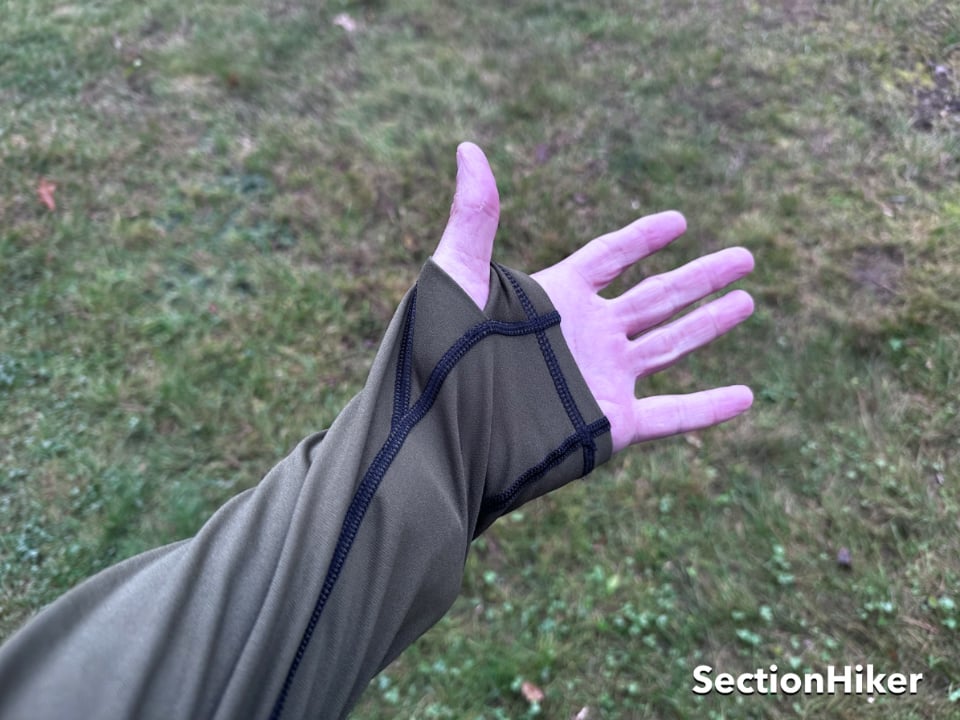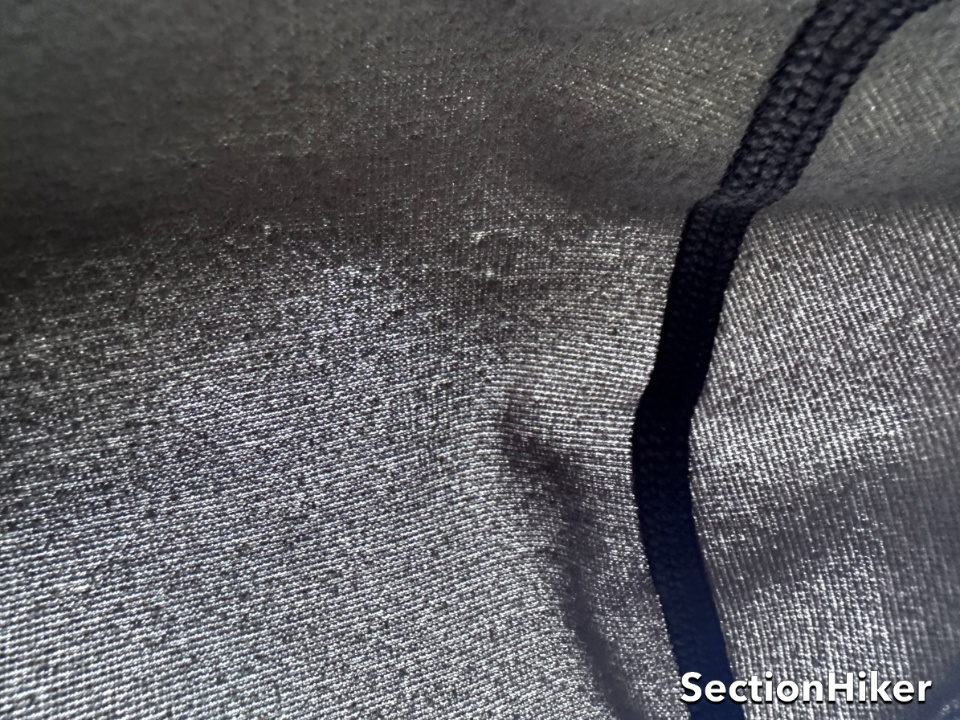
The KUIU Peloton 97 Fleece Zip-T Hoodie is a versatile and ultralight fleece hoodie that can be worn as an active outer clothing layer down to about 20 degrees but also works well as a mid-layer in colder conditions. It’s amazingly warm for its weight, a mere 5.7 oz (in a men’s XL), with a brushed synthetic fleece interior that’s hydrophobic, wicking, and treated with odor control.
KUIU, if you’re unfamiliar with the brand, specializes in making ultralight clothing, backpacks, tents, and outdoor gear for hunters and wilderness explorers. They make a lot of cutting-edge crossover clothing that male and female hikers and backpackers can benefit from. In addition to the Peleton 97 Hoodie, I can recommend their Ultra Merino 145 Zip Off Long Underwear, the KUIU Attack Pant, and the amazing ultralight Summit Star double wall tent. Good stuff.
Specs at a Glance
- Gender: Men’s
- Weight: 5.7 oz in a men’s XL
- Material: Toray Karuishi Fleece and Spandex
- Odor control: Toray Makspec Odor Control
- Layering position: Midlayer
- Temperature range: 70F – 32F
The KUIU Peleton 97 is a very thin and wicking fleece pullover that’s good to wear when you need extra warmth over a baselayer, like when climbing a steep mountain in freezing weather or hiking on a cold morning. In addition to torso and arm warmth, it has a hoody and thumb-holes that provide you with the opportunity to micro-adjust your warmth level by retaining more body heat without the need to stop and put on another clothing layer.

The Peleton 97 also excels as a mid-layer under a wind shirt, rain jacket, or soft shell jacket because it has a fine porous weave that transports moisture from your baselayer to your outer layers where it can evaporate. Thin mid-layers like the Peleton 97 are the best ones to carry for cold-weather hiking because they let you fine-tune the degree of warmth you need without perspiring because you’re too warm or freezing because you’re too cold. They also wick moisture more efficiently away from your skin and up through your layer “stack” because there’s less fabric to soak through to reach the next outer level. Moisture on your skin will chill you if you stop to rest, so it’s best to move it away from your skin as soon as possible.

Fitwise, the Peleton 95 hood is a bit oversized but still provides warmth when used without a fleece cap. I like how it encloses your neck with a turtleneck fit when you zip it up all the way. The seams are flat-locked so they don’t chafe if worn next to your skin and they are less bulky so garments made with them fit better. Personally, I’ve found the Peleton 97 fit to be true to size and there are a LOT of sizes to choose from from a men’s Medium up to a 3XL for bigger guys.
On the flip side, the hoodie does not have drawcords to adjust the size of the face opening, nor does it have a chest pocket. In addition, while it is treated with an odor control agent, the hoodie gets pretty stinky after a full day of use, enough to scare away animals and companions with sensitive noses. Despite that, I do prefer a synthetic garment like this hoodie over a Merino wool one because I’ve found synthetic garments to be much more durable than wool garments and they’re far better for wicking since wool holds onto moisture more and takes much longer to dry.
Recommendation
The KUIU Peloton 97 Fleece Zip-T Hoodie is a very thin ultralight fleece hoodie with an impressive warmth-to-weight ratio. It’s really the only garment I own that can serve multiple roles in a cold-weather layering system: as a base layer, a mid-layer, or an outer layer, which is a testament to its versatility. I like having a lot of flexibility in how I layer on cold weather hikes and a garment like this gives me the ability to really fine-tune my warmth level. A reader recommended that I try this hoodie and I’m so glad I did because it’s a keeper.
Disclosure: the author purchased this product.
SectionHiker is reader-supported. We only make money if you purchase a product through our affiliate links. Help us continue to test and write unsponsored and independent gear reviews, beginner FAQs, and free hiking guides. SectionHiker.com Backpacking Gear Reviews and FAQs
SectionHiker.com Backpacking Gear Reviews and FAQs
Neither myself or another family member had good luck with this. It’s warm fir sure but when we were actively moving, it didn’t seem to wick sweat well enough for us or breathe very well. The fleece stayed damp and or wet. Once we stopped moving, we could feel the cold. I used it to hike, he used it for hunting. He walked into the woods, in the snow. Once he got his stand up and sat is when he noticed he was wet. We both felt it kept us warm while moving though. I have a 100 weight fleece that I’ve hiked in and it wicks better than this. I still like this piece but not for active use. I understand how to manage perspiration while hiking, it’s just not a good piece for me.
If it’s wet and your baselayer is dry, it sounds like its doing what it’s supposed to be doing – wicking up and out. True, the rate it dries will depend to some extend on the humidity level, but body heat, especially when you’re working hard should make the shirt dry faster. I wear this over a very thin synthetic baselayer jersey, which is an important detail worth knowing.
I wouldn’t advocate using this piece as a warmth layer when you’re sitting still after working hard – I’d put something on over it like an insulated jacket or a thicker fleece. I think the advantage of this piece over a 100 weight fleece (which I agree is the gold standard for mid-layers) is the weight. It’s under 6 oz when a 100 weight fleece can weigh anywhere from 10 oz to 16 oz. It’s definitely not as breathable as polartec alpha but then again its also much more wind resistant and durable.
I offer it as a suggestion for something to try. You can only develop “your” layering system with lots of experimentation. There’s just no way around that.
Thank you. I do like the weight of it and it’s certainly less bulky. I was thinking of trying it as a sleep shirt on colder nights.
Funny you mention that. I’m thinking about taking mine to Scotland next spring as a sleeping top and to have in reserve as a daytime layering piece.
I really like Kuiu Peloton 97 Fleece garments, especially the Peloton 97 Fleece Zip-Off Bottoms. It’s great to wear them in the morning after getting out of the tent and being able to wear them as I start down the trail on cool/cold mornings because I can easily shed them when I get warm. Traditional bottoms I take off before I start hiking because they are a hassle to shed while hiking compared to these zip-off bottoms. Unfortunately they only do sizes medium and up, the fleece top you reviewed is nice, but in a medium is too loose for my skinny distance runner build. Many backpackers are not familiar with the Kuiu brand.
Most backpackers stick to trails these days, or so it seems. KUIU is more applicable for people who like going off-trail, like hunters, although I must admit that’s my preference these days too in terms of a real challenge (minus the hunting.)
Philip,
Good review.I found this brand 4 years ago. They have a lot of good clothing. Recommend readers check them out.
Very reasonably priced base layers and mid-layers too.
I’ve had two of these
They are indeed light But readers should be warned that they are only warm when worn on still days or when exerting at maximum – the fleece is so thin that any breeze cuts right through it. And if not exerting to perspiration levels they aren’t that warm, definitely not for base camp. Whereas a cheap lightweight synthetic fleece (or cheap thin merino wool) top while twice the weight offers twice the warmth and better performance in the wind – but less for wicking.
I found these best to use when moving fast and hard and then you want the wicking and a bit breeze cutting through is a plus.
But most of the time I don’t find them warm enough and prefer a standard light fleece.
Finally – the material in these tops is quite robust but the weave does catch on everything in the bush in Australia. Tasmania and NZ. If you are not wearing a shell then a standard fleece or wool weave is better for pushing through regrowth in our bush and doesn’t catch so much.
I just returned from a 4 day and 3 night trip and I wore my new KUIU Peloton 97 Fleece Zip-T (not the hoodie version) as my main baselayer every day. I also wore a short-sleeved merino t-shirt underneath so technically that was my base and the Peloton 97 was a mid but I wore them together 100% of the time (I just prefer a short sleeve t-shirt in cool and cold temps as a base). Mornings started out in the upper 30’s and the days had a high of upper 60’s. I’d start my mornings with a Patagonia Nano Air Hybrid over the Peloton 97 for the first hour or so until the temperature reached the low 40’s (or I started an ascent). Overall I really liked the Peloton 97 and it’s going to be my base layer for these temperatures or my first mid-layer in warmer weather when I wear a sunshirt but need something when I stop for a break or temperatures drop into the 60’s. I never felt that I was getting too hot or accumulated too much perspiration.
However, one major problem … I don’t think this is really designed as a durable outer layer since the stitching along the arms and waist is “loose” and exposed. It easily snags on tags, corners, velcro, etc. around my pack and gear. I also noticed a little “wear” on the fabric underneath the buckle on my pack hip belt so I started to lift the front of the Peloton 97 just slightly so the buckle would be underneath and riding on my pants rather than the front of the fleece. Like most ultralight gear, it will require a little extra care.
Overall, despite these shortcomings, it’s one of my new favorite pieces of clothing and will be in my pack for hot and warm temps as my first mid layer and my baselayer for cool and cold temps. I’m undecided if I’ll use this as a base or mid during ski season but I’m going to try it. My go-to base (over a short sleeve t-shirt) for skiing is a Patagoni R1 gridded fleece under a shell (with or without a variety of mid layers depending on temp). I think the R1 grid fleece may be better knowing it’s under a hard shell but the weight to warmth ratio of the P 97 is fantastic and may work just as well or better.